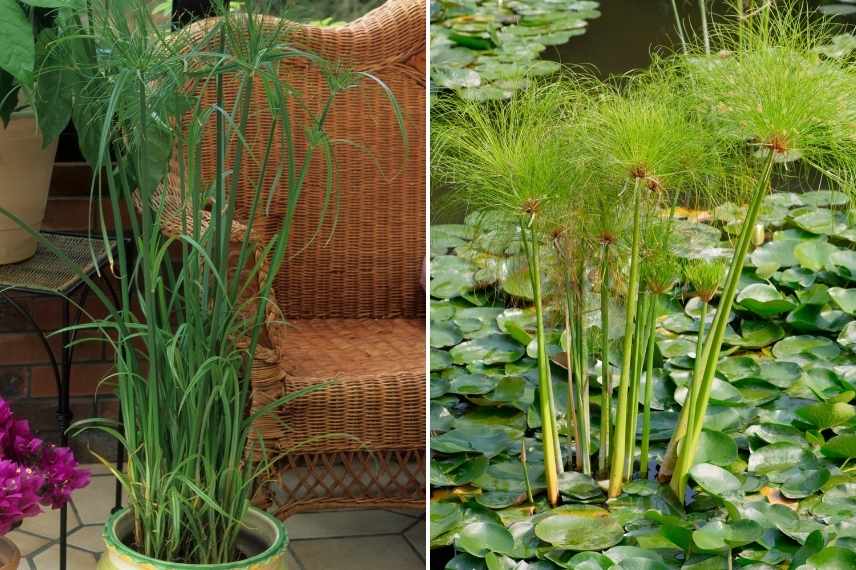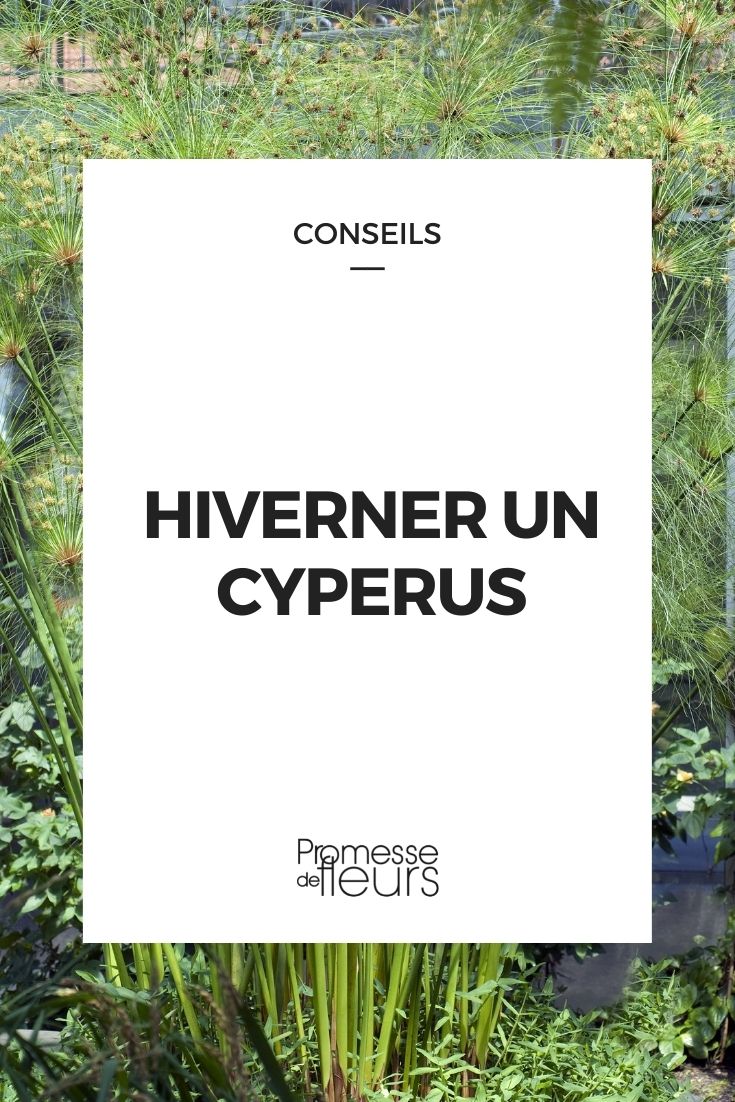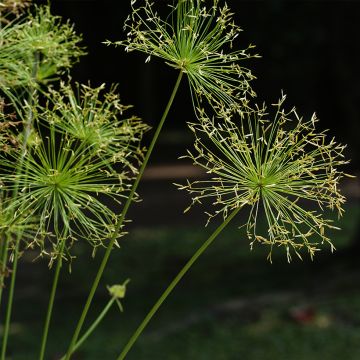
Overwintering a Cyperus papyrus
How to protect your papyrus from cold and frost?
Contents
Commonly known as Papyrus, the Cyperus papyrus (or Nile Papyrus) has become trendy in contemporary landscaping and water gardens, where its umbels transport us to Mediterranean and exotic regions. Primarily grown in pots here due to its low hardiness, this beautiful water plant requires some special care as winter approaches, allowing it to survive the cold season without issues.
In this article, we explain how to properly winter your Cyperus papyrus, whether it is planted in the ground or grown in a pot.

The Cyperus papyrus, an extraordinary perennial from warm countries, will need protection in our latitudes
→ Learn more with our guide Papyrus, planting and care
Cyperus papyrus, a mythical and ... frost-sensitive plant
Mythical plant of Pharaonic Egypt, native to the banks of the Nile and Sudan, papyrus truly takes us on a journey! It’s perfectly reasonable to fall for this spectacular hardy aquatic perennial, with its graphic appearance, its stems proudly reaching up to 2 metres or even 3 metres in its natural habitat, and its flowering with yellowish-green spikelets in an umbel shape during the height of summer… a beauty that sparkles in the sun, ultra luminous!
While true papyrus fits seamlessly into contemporary gardens and ponds around the Mediterranean, spared from severe frosts, it is essential to provide protection elsewhere, as the plant is particularly sensitive to cold: it does not withstand negative temperatures, especially if prolonged. The aerial parts of the plant will indeed disappear as soon as the thermometer drops to -3°C, but more importantly, the stump is destroyed.
N.B.: The deciduous species, Cyperus longus and Cyperus glaber, which are less ornamental, are hardy and can withstand cold, resisting down to -15°C. As for Cyperus papyrus alternifolius (native to Madagascar), with stiffer stems and inflorescences, it is also less spectacular and can resist -5°C in very well-drained soil.

Be careful not to confuse the hardy papyrus on the left, which can also be used as a houseplant, with Cyperus papyrus on the right, in a pond
Read also
Papyrus, Cyperus: planting and careWhen to winter a Cyperus papyrus?
Frost-sensitive, Cyperus papyrus does not withstand temperatures dropping below -3°C. You will need to winter your papyrus before the first frosts are forecast, depending on your region often early November, sometimes even earlier in October. As always, a plant grown in a pot suffers much more quickly than one in the ground. So be particularly vigilant with your potted Cyperus papyrus.
Discover other Cyperus
View all →Available in 2 sizes
Available in 1 sizes
Available in 2 sizes
Available in 1 sizes
Available in 1 sizes
Available in 1 sizes
Available in 1 sizes
Available in 1 sizes
Available in 2 sizes

Available in 1 sizes
How to winter a Cyperus papyrus in a pot?
It is imperative to bring your pot indoors. Place your Cyperus papyrus in a very bright and cool location: this could be a greenhouse, a conservatory, or a winter garden, any light room maintained at a temperature of 10 to 15°C, having first trimmed the dry stems back to the base.
As Papyrus requires water, ensure it is provided even in winter and indoors, in a saucer filled with water, to keep the substrate moist. You can lightly mist the stems and foliage if the atmosphere is too dry.
You will take your Cyperus papyrus outside in spring, usually in May (again, this depends on your region; it could be late April when the risk of frost has passed). The important thing for this outdoor transition is to do it gradually, by slowly bringing your Cyperus papyrus outside onto the terrace, to avoid damaging its foliage, which could scorch if exposed too long and suddenly to the sun’s rays.
Read also
Growing a papyrus in a potHow to protect your outdoor-grown papyrus?
- A papyrus growing in a humid medium
Your Cyperus papyrus grown in water is planted in a basket for young plants submerged often 10 to 20 cm deep, depending on the size of the water feature. You must absolutely outside the Mediterranean zone and Atlantic coastal fringe bring it indoors for wintering, or you risk condemning your papyrus. Proceed as indicated above, transplanting your papyrus into a container filled with potting soil. The important thing is to always place it in a very bright room and not to let your plant dry out.
- A papyrus planted in the ground
Only in regions where winters are very mild, cover the stump very generously with a thick layer of leaf mulch (as you would for tender agapanthus). The aerial parts may disappear, but the stump will not be affected, and your Cyperus papyrus will start well in spring.

Cyperus papyrus planted in the ground (© KM)
- Subscribe!
- Contents









































Comments